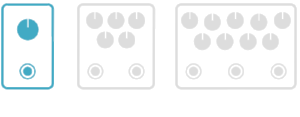MOOG MF Flange
The same guys that make all of those magnificent synthesizers also make pedals! True to their roots, Moog have made this a completely analog pedal that can make some pretty crazy noises. This wide range flanger is an old school pedal that gives the user that classic flange sound heard on many records from the 70’s. With it’s old school style come some old school problems: This is a noisy pedal.
External Control:EXP
Cost: $$
HornFX Review
Interface: 3.5/5
The four knobs are easily understood and intuitive. The “Type” switch is not clear until you learn, by hearing, what the sonic difference is.
Versatility: 3/5
This flange pedal is not among the more varied and diverse pedals of this kind. Its two “Type” modes are definitely distinct, but the variation beyond that is quite limited. Although its selections of sound types are limited, the two effect types each have a wide sweep. You are able to be quite subtle or make some insane sounds.
Clarity of Effect: 4.5/5
The pedal’s sounds truly resonate well. The tone of your horn will absolutely not overpower this effect as is sometimes the case with flangers and phasers.
Live application: 1/5
The MF’s sounds are quite high quality and it is easy to use. But, the oscillating whistle that some flangers have through a microphone when not playing, is overpowering. The pedal would have to be turned off, even during rests, to have any hope of not taking away from performance.
Product Information
The MF Flange is an all analog, BBD based harmonic manipulator pedal with a wide array of unique sound sculpting and phase manipulation capabilities. Toggle between classic flange and vocal modes. Sweep the Feedback knob to fine-tune the resonant peak of a sweep, or crank the Rate control for rapid, percussive pulsing. Push up the Depth control to transition from subtle motion into massive multi-octave sweeps, or dial back the Time and settle into smooth, analog chorusing.
PRELIMINARY SPECIFICATIONS (Specifications subject to change)
SIGNAL PATH: 100% Analog
BYPASS TYPE: True bypass
POWER: +9VDC
WEIGHT: 18oz (0.5kg)
ENCLOSURE: Cast aluminum
DIMENSIONS: D=5.75” (14.4 cm) W=3.25” (8.3 cm) H=2.25” (5.8 cm)
DELAY TIME: <0.540mS – 16mS (0.340-20mS with modulation)
LFO RATE : <.025Hz - >11Hz
LFO SHAPE: Exponentiated Triangle
EXPRESSION: Controls Time (Max Input level +5VDC)
INPUT IMPEDANCE: >1 MegaOhm
OUTPUT IMPEDANCE: 1000 Ohm Max
MAX INPUT LEVEL: +7.5dBμ
MAX OUTPUT LEVEL: +10dBμ
CURRENT: 18mA Nominal / 22mA Max
STEREO OUTPUT MODES:
TYPE SWITCH UP - Left (Mono) Output = Dry + Wet / Right Output = Dry - Wet
TYPE SWITCH DOWN - Left (Mono) Output = Dry - Wet / Right Output = Dry + Wet
Rate: At Minimum position sweeps are gradual and fluid. As rate is increased, the movement becomes tighter and more focused. At maximum position, the modulation sound becomes is rapid and transitions to hard, percussive pulsing.
Depth: Determines the amount of modulation applied to the delay time. As depth is increased, the sound transitions from light motion and phasing all the way into massive multi-octave sweeps.
Time: At maximum position you can easily craft traditional or vocal, metallic flange sounds. As the Time control position is reduced, delay time is increased and sounds become thicker and warmer. At Minimum position, the MF Flange is capable of approaching analog chorus.
Feedback:This control brings focus and resonance to the sweep of a sound. At minimum position, sweeps are smooth and neutral. At medium position, sweeps begin to peak musically. At maximum position, the sound of a sweep becomes rigid and metallic.
TYPE: The lower position subtracts feedback from the input signal mixer and output dry signal creating a more vocal sound. In the Upper position, feedback is positively summed with the input signal and dry signal, producing a more traditional flanger sound.
EXPRESSION PEDAL INPUT: This input is assigned to the Time control. Use an expression pedal to manually sweep through the delay frequency range of the MF Flange.
MONO/STEREO SWITCH: To access both outputs (in bypass), you will need to remove the bottom of the MF Chorus and set this switch to Stereo. Then use a ¼” TRS to TS insert cable or TRS to TS splitter.
WARNING: When set to Stereo and in bypass, excessive loading may occur. To avoid this, set this switch to Mono. A stereo output will still be present.
• True Bypass
• 100% analog wide-range Flange
• Extreme time and phase manipulation possibilities
• Mono or Stereo out
• Designed to perform with any Guitar, Amp, or Bass guitar configuration
Product info from the Moog website.

